The Stull shale member of the Kanwaka formation crops out extensively in Nebraska, Iowa, and Kansas. The Stull is often a medium gray, silty shale that has a diverse fauna that includes corals, bryozoans, brachiopods, mollusks, arthropods and echinoderms. Many of these fossils are large and have robust, ornamented shells that suggest they lived in fairly well oxygenated, shallow water near an ancient shore.
Brachiopods are bivalved animals that superficially resemble clams; their two valves are unequal in size and shape. Brachiopods usually open their shell in a plane that is perpendicular to their plane of symmetry whereas clams normally open their shells in a plane that is parallel to their plane of symmetry. The Stull has a large, diverse brachiopod fauna that may contain more species than any other stratigraphic unit in the mid-continent Pennsylvanian. Both articulate and inarticulate brachiopods are found in the Stull. Species of most of the major groups of articulate brachiopods have been found in the Stull.
Brachiopods are sessile (non-moving) benthic (bottom dwelling) animals that fed on food particles such as microscopic plants and animals, larvae of animals, and decayed matter that were suspended in the water column in which they lived. Such animals are called suspension feeders. Brachiopods may have been attached to the substrate by a fleshy pedicle, anchored in the substrate by spines, or cemented to a hard object such as a rock or shell of another animal.
We have not attempted to give a formal classification of brachiopods here as that is beyond the scope of this page. Instead, we have followed the suggestions of Alwyn Williams (1956) who described brachiopods in terms of their calcareous shells and the shapes and structures common to the various groups.
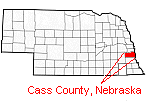
Inarticulate
All of the previously viewed brachiopods are called articulate brachiopods---that is, they open their shells with a system of teeth and sockets that serve as a hinge that is controlled by adductor and diductor muscles that close and open the valves when the need arose. Inarticulate brachiopods, however, have no teeth or sockets and open their shells by an entirely muscular and ligament process. Articulate brachiopods have calcium carbonate shells whereas inarticulate brachiopods have calcium phosphate shells. The larval lives and stages of the two kinds of brachiopods are also different.

Orbiculoidea missouriensis
Description: "Orbiculoidea missouriensis" (Shumard) is the most common inarticulate brachiopod. This species is common in black, offshore shale, but some may become quite large in near shore shale environments where nutrients were more abundant.
Terebratuloid
These are characterized by having ovate, smooth shells with pedicle openings. See the examples of recent brachiopods from New Zealand. Most extant brachiopods are terebratuloids, which appear to be closely related to such forms as the atrypoid brachipods such as Composita. Such is not the case. The former has its food gathering system supported by a large, single loop inside the shell whereas the latter has it food gathering system supported by spiralia.

Becheria bovidens
Description: "Becheria bovidens" (Morton) is a very long ranging species of terebratuloid brachiopod that extends through most of the Pennsylvanian rocks of the mid-continent. However, it usually occurs only in small numbers and rarely, if ever, is the dominant brachiopod of any assemblage.
Atrypoid
Atrypoid brachiopods are similar to spiriferoid brachiopods inasmuch as they also have spiralia. Atrypoid brachiopods, however, have short hinge lines and their shells may be either smooth or plicated.
Note on Composita: In their classic 1932 study "Brachiopoda of the Pennsylvanian System in Nebraska" Carl O. Dunbar and George E. Condra recorded at least four species of Composita from Nebraska. These are shown in the illustrations for your reference. Subsequent workers such as Norman Newell in Kansas and Myron Sturgeon and Richard Hoare in Ohio continued to recognize the species that were recognized or erected by Dunbar and Condra. Anne Lutz-Garihan studied a large number of Composita from the early Permian strata of Kansas and Oklahoma and showed that the genus was represented by an intergradational series of individuals that varied morphologically between two end members and none could be separated into groups that could be interpreted as separate species. Further, Lutz-Garihan showed that the end members did not differ in abundance and distribution in rock types, stratigraphic horizons or geographic areas and could not be explained as ecophenotypes, evolutionary populations or subspecies. Although Composita and its species have not been studied in the same detail as Lutz Garrihan's material, the genus shows a great variation in the Stull Shale of Nebraska, Iowa and Kansas.

Composita elongata
Description: "Composita elongata" Dunbar & Condra is usually much longer than wide.
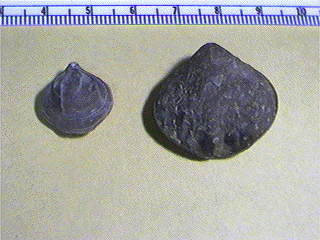
Composita ovata
Description: "Composita ovata" Mather is nearly round except near the beak.
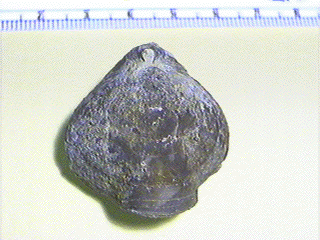
Composita subtilita
Description: "Composita subtilita" (Hall) is longer than wide and is tear-drop shaped. It lacks the parallel sides of "C. elongata".
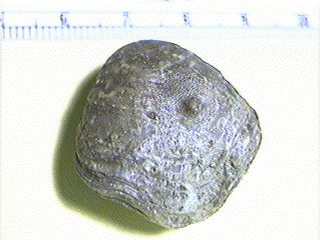
Composita subtilita
Description: "Composita subtilita" served as a hard substrate for a bryozoa colony.
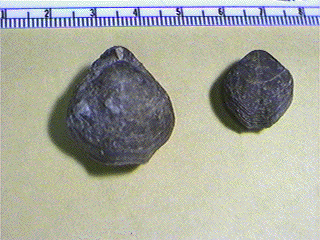
Composita trilobata
Description: "Composita trilobata" Dunbar & Condra has a deep fold and sulcus that gives the shell a trilobed appearance.
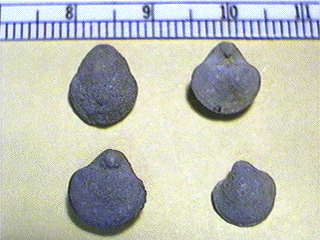
Crurithyris planoconvexa
Description: "Crurithyris planoconvexa" (Shumard) is a very small species of brachiopod that rarely exceeds 6 or 7 mm along the hinge line. It has a highly inflated pedicle valve and a nearly flat brachial valve. This species is often very abundant when it is found.
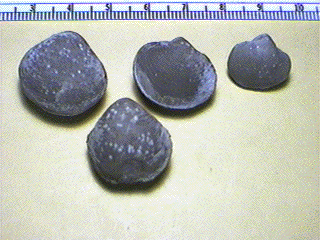
Phricodothyris perplexa
Description: "Phricodothyris perplexa" (McChesney) differs from the similar appearing Composita subtilita in having very well defined growth lines and numerous tiny spines covering its shell. "P. perplexa" is usually much scarcer than "C. subtilita".

Hustedia mormoni
Description: "Hustedia mormoni" (Marcou) is a very small brachiopod that rarely exceeds 10 to 12 mm in length. It is characterized by the coarse costae (radial, rib-like features) and is relatively scarce although it ranges throughout the Pennsylvanian in the mid-continent.
Spiriferoid
Spiriferoid brachiopods usually have long hinge lines and well-developed teeth and sockets. They have plicated or coarsely ribbed shells and probably attached to the substrate by a fleshy pedicle that protruded through a large, V-shaped pedicle opening. Their name is derived from a pair of internal structures called spiralia which are shaped like coil springs. The spiralia supported their food gathering mechanisms that in modern brachiopods resemble feathery tentacles.
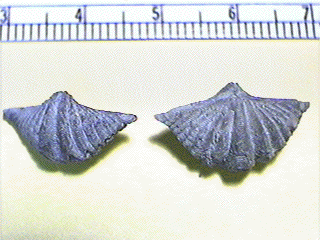
Punctospirifer kentuckyensis
Description: "Punctospirifer kentuckyensis" (Shumard). Although "Punctospirifer" appears to be a juvenile Neospirifer, the former has punctations (tiny pin holes) all over its shell whereas the latter does not.
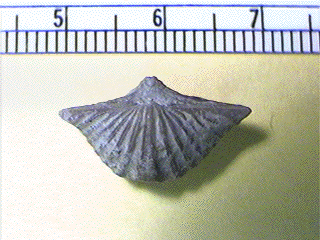
Punctospirifer kentuckyensis
Description: "Punctospirifer kentuckyensis" (Shumard). Although "Punctospirifer" appears to be a juvenile Neospirifer, the former has punctations (tiny pin holes) all over its shell whereas the latter does not.

Neospirifer triplicatus
Description: "Neospirifer triplicatus" Dunbar & Condra. Neospirifer triplicatus is one of the more common large brachiopods to have lived in Nebraska. There is a great deal of variation in morphology (form) of these brachiopods and their classification is perplexing even to professional paleontologists.
Strophomenoid
These brachiopods can become rather large, some having shells of 75 mm (3 inches) in diameter. Their pedicle opinings are usually filled with small calcite plates. Strophomenoid brachiopods probably remained immobile in the mud into which the extended their long, steeple-like beaks. The valves are commonly flattened toward the anterior and they have a circular outline with very fine costae. These brachiopods often have very well developed muscle scars on their interiors. Derbyia, Schuchertella and Streptorhynchus appear to be the most common genera of strophomenoid brachiopods in Nebraska.

Becheria bovidens
Description: "Becheria bovidens" (Morton) is a very long ranging species of terebratuloid brachiopod that extends through most of the Pennsylvanian rocks of the mid-continent. However, it usually occurs only in small numbers and rarely, if ever, is the dominant brachiopod of any assemblage.
Chonetoid
Chonetoid brachiopods are typified by having nearly semi-circular shells with flat to only slightly inflated brachial and pedicle valves. They have spines along the hinge line of the pedicle valve and the pedicle opening is closed up with tiny plates. Chonetoid brachiopods appear to be most common in fairly muddy water environments. They may have fixed themselves to the substrate by sinking their spines in the muddy bottom. There are a number of genera of chonetoid brachiopods with the suffix " —chonetes" which should be pronounced "cone eat ease".

Neochonetes granulifer
Description: "Neochonetes granulifer" (Owen) is a very long-ranging species that has been observed throughout the Pennsylvanian section of Nebraska. It may often make up over 75 percent of the invertebrate macro-fossils of any assemblage and may make up 90 percent or more of the total brachiopod fauna in that assemblage.
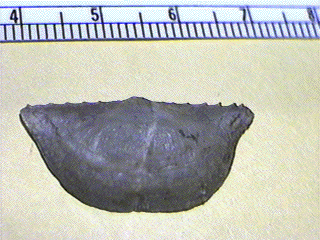
Neochonetes granulifer
Description: "Neochonetes granulifer" (Owen) is a very long-ranging species that has been observed throughout the Pennsylvanian section of Nebraska. It may often make up over 75 percent of the invertebrate macro-fossils of any assemblage and may make up 90 percent or more of the total brachiopod fauna in that assemblage.
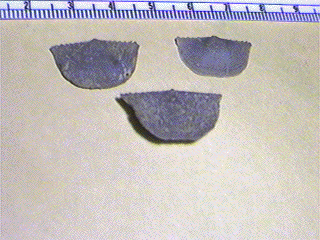
Neochonetes granulifer
Description: "Neochonetes granulifer" (Owen) is a very long-ranging species that has been observed throughout the Pennsylvanian section of Nebraska. It may often make up over 75 percent of the invertebrate macro-fossils of any assemblage and may make up 90 percent or more of the total brachiopod fauna in that assemblage.
Productoid
Productoid brachiopods are characterized by having highly inflated, and spinose pedicle valves, long hinge lines, and large beaks. The spines may be several inches long. Some genera such as Antiquatonia have but a few robust spines whereas others such as Pulchratia have numerous, fine spines. Some productoid brachiopods probably settled into a soft substrate by imbedding their spines in the soft substrate whereas some productoids appear to have cemented their spines to a hard object in the substrate. There are several distinct species of productoids in the Pennsylvanian of the mid-continent. Growth series have generally not been constructed for many of these brachiopods so it is not known which "species" are valid and which are growth stages of a described species.
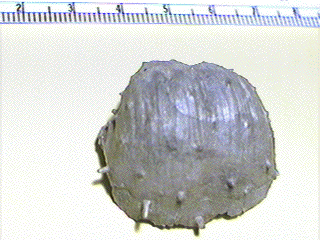
Antiquatonia portlockianus
Description: "Antiquatonia portlockianus" has been observed in both nearshore and offshore environments. This species commonly reaches 35 mm to 40 mm measured along the hinge line.
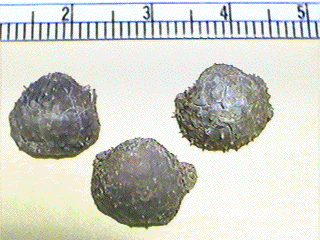
Cancrinella boonensis
Description: "Cancrinella boonensis" (Swallow) is a typically small productoid brachiopod that measures about 10 mm along the hinge line. It is a fairly uncommon brachiopod. Since juveniles of many invertebrates have a very high mortality rate, it may be that C. boonensis is not a growth stage of some larger brachiopod.

Leptalosia ovalis
Description: "Becheria bovidens" (Morton) is a very long ranging species of terebratuloid brachiopod that extends through most of the Pennsylvanian rocks of the mid-continent. However, it usually occurs only in small numbers and rarely, if ever, is the dominant brachiopod of any assemblage.
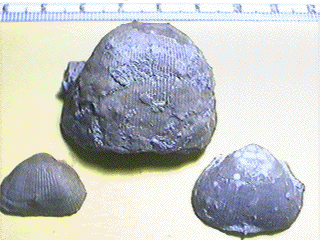
Linoproductus prattenianus
Description: "Linoproductus prattenianus" (Norwood and Pratten) is characterized by fine costae which differentiate it easily from "Antiquatonia" and "Reticulatia. L. prattenianus" has only a few robust spines on the pedicle valve. "Linoproductus" has a hinge line that is often 60 mm to 70 mm long; however, the "ears" that make up much of the length are frequently not preserved.

Juresania nebrascensis
Description: "Juresania nebrascensis" (Owen) is characterized by numerous tiny spines that are more or less evenly spaced along the growth lines of the inflated pedicle valve. The brachial valve is usually very flat. J. nebrascensis seemed to prefer warm, shallow water, near-shore environments where it may be abundant. The Bonner Springs Shale that was once exposed in an abandoned quarry near Louisville yielded several hundred specimens of "J. nebrascensis" that were shown to have highly variable cardinal processes by J. A. Fagerstrom and John Boellstorff. Brachiopods are exclusively marine bivalved animals. They were common in the Paleozoic seas that covered much of North America but their numbers and diversity have decreased since the beginning of the Mesozoic. Most of the modern brachiopods belong to the terebratuloid group
Orthoid
These brachiopods often had large beaks that may have been pressed into the mud to stabilize the shell. Orthoids usually have highly inflated valves with very fine costae and short hinge lines. There are only two genera of these rather primitive brachiopods that have been recorded in Nebraska: Enteletes and Rhipidomella.
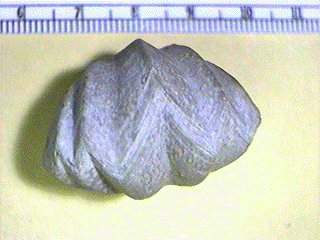
Enteletes pugnoides
Description: Many fossil collectors and paleontologists alike regard "Enteletes pugnoides" Newell as one of the most attractive brachiopods to be found in the Pennsylvanian strata of the mid-continent. This species is rather uncommon and it may reach diameters of up 35 mm. The coarse plications and very fine costae characterize this species.

Enteletes pugnoides
Description: Many fossil collectors and paleontologists alike regard "Enteletes pugnoides" Newell as one of the most attractive brachiopods to be found in the Pennsylvanian strata of the mid-continent. This species is rather uncommon and it may reach diameters of up 35 mm. The coarse plications and very fine costae characterize this species.
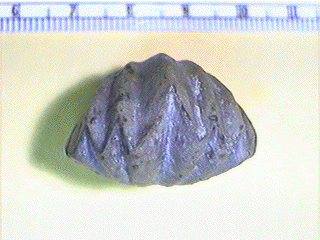
Enteletes pugnoides
Description: Many fossil collectors and paleontologists alike regard "Enteletes pugnoides" Newell as one of the most attractive brachiopods to be found in the Pennsylvanian strata of the mid-continent. This species is rather uncommon and it may reach diameters of up 35 mm. The coarse plications and very fine costae characterize this species.
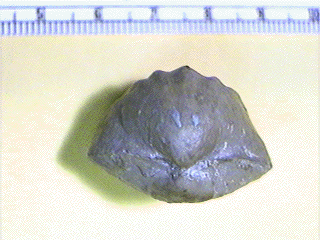
Enteletes pugnoides
Description: Many fossil collectors and paleontologists alike regard "Enteletes pugnoides" Newell as one of the most attractive brachiopods to be found in the Pennsylvanian strata of the mid-continent. This species is rather uncommon and it may reach diameters of up 35 mm. The coarse plications and very fine costae characterize this species.
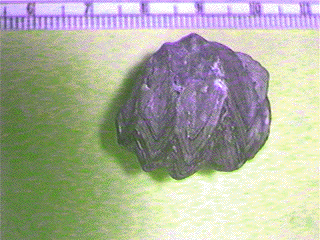
Enteletes pugnoides
Description: Many fossil collectors and paleontologists alike regard "Enteletes pugnoides" Newell as one of the most attractive brachiopods to be found in the Pennsylvanian strata of the mid-continent. This species is rather uncommon and it may reach diameters of up 35 mm. The coarse plications and very fine costae characterize this species.

Enteletes pugnoides
Description: Many fossil collectors and paleontologists alike regard "Enteletes pugnoides" Newell as one of the most attractive brachiopods to be found in the Pennsylvanian strata of the mid-continent. This species is rather uncommon and it may reach diameters of up 35 mm. The coarse plications and very fine costae characterize this species.
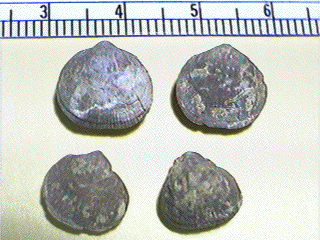
Rhipidomella carbonaria
Description: "Rhipidomella carbonaria" (Swallow) is a very small species that is about 8 mm to 10 mm in diameter in adult forms. This species is common in offshore shale although this one was collected from a nearshore shale.
Rhynchonelloid
These small brachiopods are usually wedge shaped, they have sharply pointed beaks and minute pedicle openings. The pedicle valves have deep folds with coarse plications. They appear to be represented by only two species in Nebraska, Wellerella osagensis (Swallow) and Rhynchopora sp.
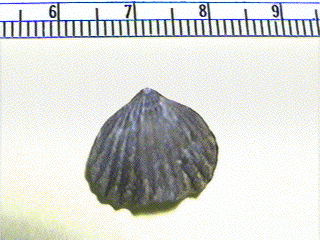
Rhynchopora illinois
Description: "Rhynchopora" sp cf. R. "illinoisensis" (Worthen). "Rhynchopora illinois" was known from but a single crushed shell in Nebraska that was recorded by Dunbar and Condra in 1932. These specimens were brought to light by amateur collector, Ed Schafer, from Omaha who collected them from a quarry near Weeping Water.
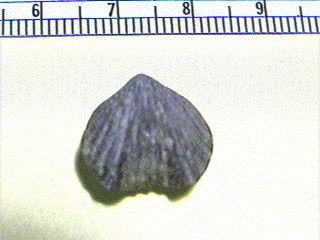
Rhynchopora illinois
Description: "Rhynchopora" sp cf. R. "illinoisensis" (Worthen). "Rhynchopora illinois" was known from but a single crushed shell in Nebraska that was recorded by Dunbar and Condra in 1932. These specimens were brought to light by amateur collector, Ed Schafer, from Omaha who collected them from a quarry near Weeping Water.
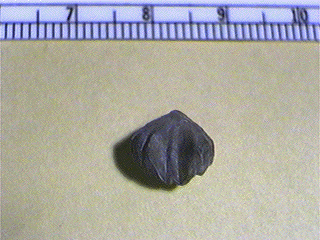
Wellerella osagensis
Description: "Wellerella osagensis" (Swallow) is a small species that rarely attains a diameter over 8 mm to 10 mm.
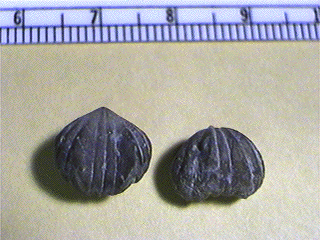
Wellerella osagensis
Description: "Wellerella osagensis" (Swallow) is a small species that rarely attains a diameter over 8 mm to 10 mm.
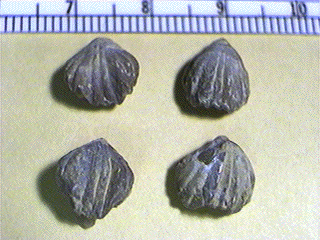
Wellerella osagensis
Description: "Wellerella osagensis" (Swallow) is a small species that rarely attains a diameter over 8 mm to 10 mm.